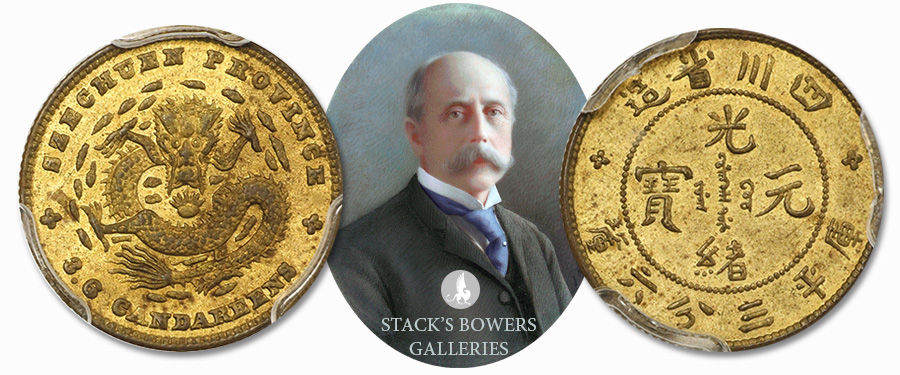
In 1896 the Chinese government contracted the Ferracute Machine Company to produce coin presses for a new mint in Chengtu in Szechuan Province. Ferracute contacted the U.S. Mint, one of its customers, about producing pattern coins to showcase the capabilities of its presses. Charles Barber, then chief engraver at the Mint, produced a set of patterns based on the Kwangtung dollar; in 1896 or early 1897, patterns were struck using Barber’s dies. Work on the presses was completed in March 1897.
Barber’s patterns were shipped to Sichuan alongside the Ferracute presses, a lengthy journey of 13 months. The dies were badly damaged, submerged in the Yangtze River for six weeks after the riverbank on which the shipment was being stored flooded. A few patterns were produced from the rusted dies. Engravers at the Chengtu Mint attempted to recreate the dies but, according to numismatic historians, were unable to replicate the detail of the Ferracute patterns (as Barber’s pieces are known). Only a handful of the patterns produced from the original dies survive. The Chengtu Mint was in operation by June 1898.
Dragon Dollars and their subsidiary denominations were first issued in 1890, struck initially at the Kwangtung Mint. The reverse dragon motif from which the coins’ nickname is derived is perennially popular with collectors. Examples of obscure pattern and rare regular issues often command massive prices and are prominently featured in auctions around the world.
Modern reproductions of Barber’s patterns are available to collectors today, produced in gold, silver and brass by the Smithsonian in 2018. Ellen Feingold, curator of the Smithsonian’s National Numismatic Collection, said at the November 2017 opening of an exhibit featuring the coins, “In the late 19th and early 20th centuries, China sought to set up provincial mints and produce struck coinage en masse, but it did not have the technical capabilities to manufacture the necessary minting equipment. Representatives of private overseas firms, including American firms, traveled to China and worked with Chinese officials to design, manufacture, and export minting equipment for multiple Chinese mints. Americans even engraved designs for some of China’s most iconic modern coins from that period. For example, the Ferracute Machine Company of Bridgeton, New Jersey, worked with U.S. Mint Chief Engraver Charles Barber to produce brass gilt proof pattern coins for the Sìchuān province around 1902.”
A set of the Barber patterns, certified by NGC, was exhibited at the 2017 ANA World’s Fair of Money. Stack’s Bowers Galleries recently sold a brass 3.6-candareens (5-cent) Ferracute Pattern in our October 2022 Hong Kong sale, where it realized $22,800, more than twice its $5,000 to $10,000 estimate.





